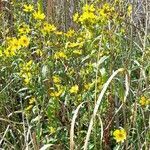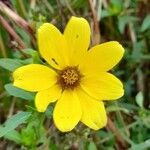Annuals (sometimes persisting), (10–)20–60(–120+) cm. Leaves (sometimes in 3s or 4s) sessile; blades obovate or elliptic to lanceolate or linear, (20–)50–100(–160+) × (5–)10–25(–40+) mm, bases cuneate to rounded, margins usually coarsely dentate to serrate, sometimes ciliate, apices acute to acuminate, faces glabrous. Heads (erect at flowering, sometimes nodding in fruit) borne singly or in open, ± corymbiform arrays. Peduncles (10–)20–60 mm. Calyculi of 5–7(–9+) erect or spreading to reflexed, oblanceolate or lanceolate to linear, often foliaceous bractlets or bracts (6–)10–12(–20+) mm, margins usually ciliate, abaxial faces glabrous or bases hispidulous. Involucres turbinate to hemispheric or broader, (4–)6–8(–10+) × 8–12+ mm. Phyllaries 8–12, ovate or obovate to lance-oblong, (4–)6–8(–10+) mm (tips often orange to purplish, as are tips of paleae). Ray florets usually 7–8, rarely 0; laminae orange-yellow, (10–)15–25(–30) mm. Disc florets (25–)60–100(–150+); corollas yellow to orange-yellow, 3–6.5 mm. Cypselae blackish, red-brown, or stramineous, obcompressed, flattened or unequally 3–4-angled, ± cuneate, outer 6–8 mm, inner 8–10 mm, margins retrorsely ciliate or barbed, apices ± truncate to convex, faces ± 1-nerved, ± striate, glabrous; pappi of 2–4 ± erect, retrorsely barbed awns 3–5 mm. 2n = 22, 24.
More
Much like no. 2 [Bidens cernua L.] wholly glabrous, sometimes perennial; heads not so consistently nodding; outer invol bracts scarcely leafy, seldom surpassing the disk; rays 1.5-3 cm; receptacular bracts reddish at the tip; achenes 3-4-angled, or often flat; pappus of 2-4 retrorsely barbed awns; 2n=22, 24. Low, wet places, sometimes in shallow water, chiefly but not wholly coastal; N.H. and Mass. to Fla. and Calif., s. to S. Amer. Aug.-Nov. Passes into no. 2.
A herb. It grows 30-120 cm tall. The leaves are opposite and without stalks. They are sword shaped and 5-15 cm long by 2-3 cm wide.




